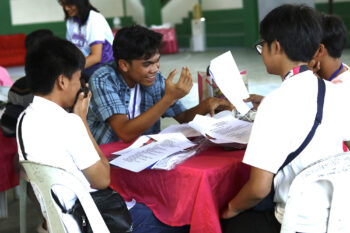VIENTIANE, Laos (MindaNews/2 May) — Always in tandem, the Lao People’s Democratic Republic and Communist Party flags were the first things that struck me when I landed in Vientiane a year ago. It’s a country, indeed, and a communist-led state. But, other than that, I never knew anything else about it before I became a fellow of FK Norway exchange program.
Laos. Sabaidee. Tuktuk. Monks. Temples. Old French buildings. Sticky rice. Papaya salad. Beerlao. Fried crickets. Baci. Lamvong. Mekong River. Tourists. Flags. And more flags in tandem.
These things had always been present wherever I went, from north to south, and even in one of the 4,000 islands or Si Pan Done.
As I had tried each day to live here like the locals, and learned their language, culture, history, and economic and political conditions, there is more than meets the eye. My fellow expatriates could have known many things about Laos which tourists might have missed.
But, what made them stay? It’s definitely beyond the beautiful sceneries in the countryside.
Coming from an archipelago, how did I survive a year-long program in a landlocked country? It’s also beyond finding a warm community of Filipinos here, who gave me a sense of home, especially during my first few weeks.
There are several things that one who’s out from his or her comfort box would complain about aside from spicy Lao foods.
For one, the weather here is extreme for a Filipino like me who had been overseas for the first time. In rainy season, it rained almost every day, sometimes like crazy. From December to February, it was so cold up to 10 degrees Celsius in Vientiane, but it got lower than that in the Northern provinces. And, when summer came, 40 degrees or above was just a normal day.
But, I didn’t come here for R&R (rest and recreation) though. Like all other expats, either volunteers or employees, I am here for a purpose. And, my purpose turned out to be more than achieving FK Norway’s vision.
FK envisions a globe that has no boundaries. One world, so to speak, through peace among nations. This can be achieved by understanding a country’s culture and helping each other through an exchange of professional knowledge and skills.
As a journalist in exchange, I have seen differences in the working style and approach to journalism between Laos and the Philippines. To note, the Vientiane Times newspaper, which is my host organization, along with other media outlets here, is run and owned by the Lao government.
This fact made me realize that I need to learn more about journalism and how it is being practiced in other Southeast Asian countries. As I shared my knowledge and transferred some skills to my colleagues in Vientiane Times, they also taught me some important lessons, including being resourceful and patient in pursuing a story idea.
My colleagues were my first friends, first Lao language teachers and first tour guides. And, eventually, they gave me confidence to explore the country and learn new things by myself. I was also able to cross the borders to Cambodia, Thailand and Vietnam. Having a glimpse of what it’s like in Laos’ neighboring countries, I have further understood the Lao people and their culture.
Then, I took initiatives to build my own network of ordinary citizens, government employees, and a few international non-government organizations here. This, I consider as improvement of my professional skills.
Part of my personal growth is being tolerant to different cultures. Vientiane Capital is becoming a melting pot of diverse people, both tourists and expats. And, as I became accustomed to the laid-back lifestyle, I learned to be more patient.
Southeast Asians give more value to space and creativity, rather than being conscious of the time as most Westerners. This was confirmed by Dr Felipe de Leon, Jr., chairperson of the Philippine National Commission on Culture and the Arts, during his visit last March. He gave lectures to Lao professionals and the Filipino community here.
Southeast Asians might be different in so many ways, but we have shared cultural heritage, according to him. Some of which that I observed among Lao people is the tolerance of other races, difficulty of saying “no”, and the “tendency to like stories with happy endings.”
Art as well is not confined to specialists but includes everyone like women who weave cloth, and farmers who are also carpenters and craftsmen in remote villages.
As a representative of FK Norway, I salute the Lao people, especially the farmers, fishermen, workers, vendors, security guards, house cleaners and waiters. They, who silently smile and serve all those who come to Laos, continue to aspire and hope for a better life. An exchange of simple greeting, “Sabaidee” (Hello) or “Khop jai” (Thank you) and nop (holding palms together while bowing), is precious for them.
By the time that I’d fly back to my country, I would imagine all my friends and the Lao people that I’ve met and their stories, as I watch those dancing flags in tandem, hopefully not for the last time.
(Lorie Ann Cascaro of Mindanews was a fellow of FK Norway exchange program. She had been in Laos and hosted by Vientiane Times.)
